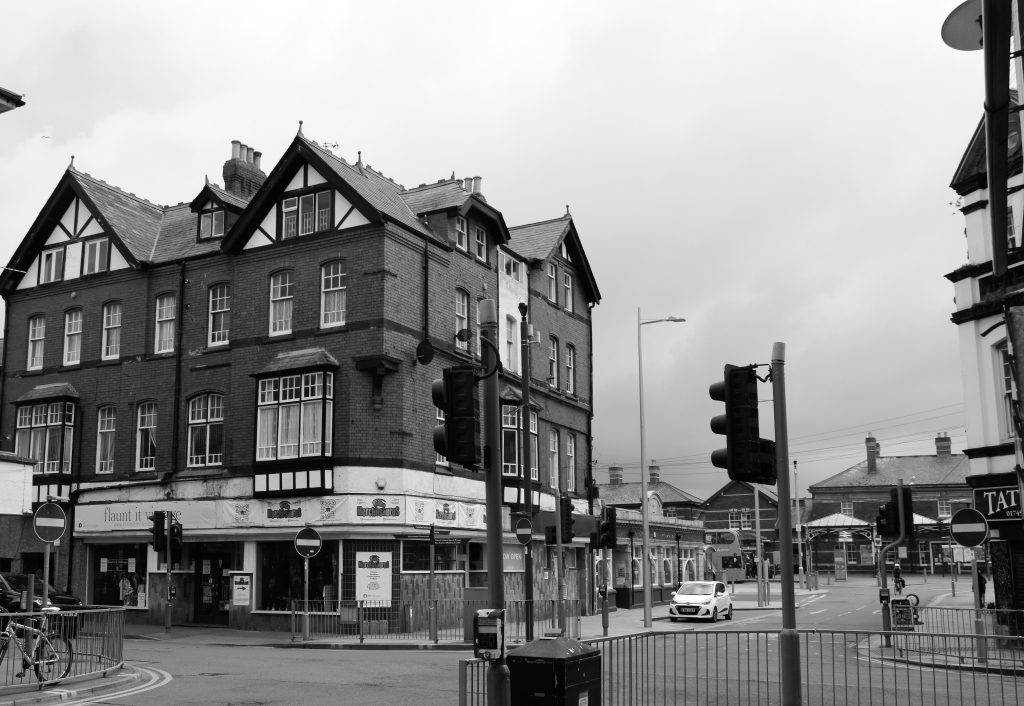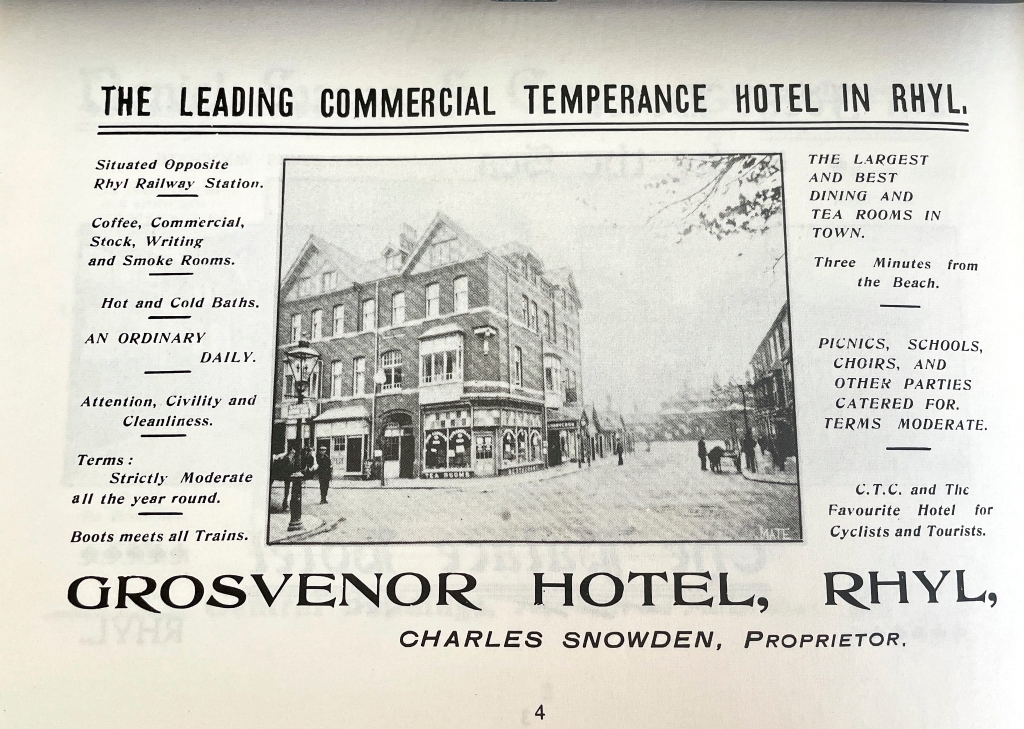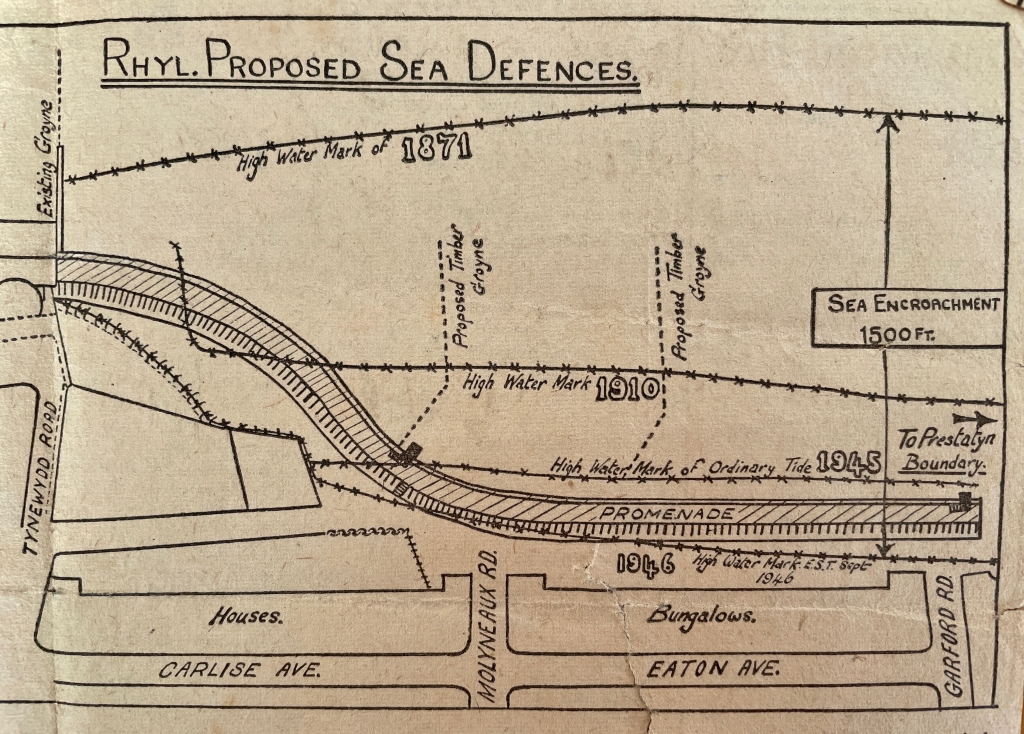The corner of Bodfor Street and Kinmel Street with the Railway Station at the back of the image.


Filed under Buildings/Location

Seventy five years ago, in January 1947, the Liverpool Daily Post described plans for a new defence scheme to protect East Rhyl from the sea at a cost of £160,000, to include an extension of the promenade. The article stated that “Two and a half miles of sea front is protected by the promenade. The erosion has taken place at the end of the promenade because the sea, unable to make any inroads into the concrete sea wall, has taken advantage of the first weak spot.”
Mr T. Lomax, surveyor to the Urban Council was afraid of the consequences if the new scheme did not begin immediately. He said ” between 1871 and 1945 the high water mark had advanced 1,500ft” (457 metres). When asked what the effect the new promenade would be on Prestatyn, which has practically no form of sea defence, Mr Lomax said “The promenade will go right to the Rhyl-Prestatyn boundary. If Prestatyn does not proceed with a scheme the sea will cause considerable erosion at the end of the new wall, just as it had done for years at the end of the old promenade.”
Work to protect East Rhyl from the sea is, of course, being carried out today and lots of information about this can be found by clicking here.
Filed under Buildings/Location, Maritime

It is 30 years since the opening night of the New Pavilion Theatre. The occasion was billed as “First Night on the Prom” and was held on Wednesday, September 25th 1991. Mr Ednyfed Williams was the compère for the evening which featured Rhyl Youth Choir, Iwan Davies (Tenor), Clwyd Singers, Glenys Roberts (Soprano), Gay Harris Dancers, Point of Ayr Colliery Band and Trelawnyd Male Voice Choir. A welcome song (D. Hughes Jones) introduced the evening and was sung by Rhyl Youth Choir, conducted by Jefferson Thomas.

The original Grand Pavilion had been opened exactly 100 years earlier in September 1891, to read more about this click here
This pavilion was lost to fire in 1901.

A new pavilion for Rhyl was built in 1908 and demolished in 1974.

It was described in the 1991 Programme by Gwynedd Parry (the first President of Rhyl History Club):
“It was built in 1908 in less than six months at a cost of £16,500, seating just over 1000 people. The outstanding feature of the building was the huge centre dome; nowhere in Wales had such a span of ceiling been built without supporting pillars.
My earliest memory of this New Pavilion, as a young lad, was the Boxing Day Eisteddfod held there, which attracted hordes of enthusiastic competitors to this Mecca of culture; soloists, choirs and elecutionists etc. One local elecutionist during World War 1 became famous for her patriotic rendering of a poem entitled “Stick it to the Welsh”! The man responsible for founding and producing this great event was Mr W. Parry, the School Attendance Officer, who was the kindest, mildest character you could imagine, and a prominent member of the Welsh Baptist Chapel. The outbreak of WW11 sadly ended all this effort.
The Pavilion did a great service for Rhyl in so many ways; for example; the May Day Festival, culminating in the crowning of the May Queen. Nowhere but the Pavilion could stage such a Grand Finale to accommodate the scores of children taking part in the Festival
Top International artistes graced the stage at Sunday night concerts; Paderwski, Dame Nellie Melba, Mark Hambourg, Rosina Buckman, Clara Butt, Albert Sammons and more recently Dame Myra Hess under the aegis of Rhyl Music Club, which put on many superb events. And of course we have happy memories of our own Emlyn Williams and David Lloyd.
The Pavilion was filled and thrilled to hear performances by the Rhyl and District Choir of “Messiah”, “Elijah”, and other oratories. Then there were the “Musicals!”, The Garden of Allah, No, No, Nanette, The Belle of New York, Rose Marie, The Girl Friend etc. The Manchester Rep. was billeted here in WW11 and charmed us with their excellent performances. The Operatic Society and The Liberty Players never failed to give of their best.
Many of the artistes and titles I have named will hardly be known by this generation, but in their day they were as well known as today’s Pavarotti, Cliff Richards, Tom Jones, the Beatles or Morecombe and Wise.
One never to be forgotten appearance on this, the largest stage in North Wales, was a diminutive figure, and it was simply his entrance which electrified the packed audience. It was David Lloyd George at a pre-election meeting. The memory still lingers.
When in 1974 the Pavilion was demolished everyone in the town felt bereft, it was like losing a dear friend. Today, out of the ashes there has arisen the New Theatre. Let us wish it success and prosperity as we launch into the future.”
The programme continued with a welcome message from Councillor F.P. Selby, the then Mayor of the Borough of Rhuddlan, a photograph of the Theatre Manager Giles Ballisat and pen portraits of the performers.

2021 update – Unfortunately the main water tank in the New Pavilion Theatre burst in July of this year which left the 1891 restaurant severely damaged, and the box office, lobbies and toilets also damaged. There is no current date for reopening but we all look forward to our lovely restaurant and theatre re-opening in the not too distant future.
Filed under Buildings/Location, Entertainment
Readers of this blog may remember a post written a few years ago about the fascinating story of Flying Fox which is proudly displayed above the Royal Alexandra Hospital. to read this article again click here.
Mr Rodney McCully has kindly shared with us an interesting piece that he has written about this famous racehorse, its importance in the history of the hospital and his trip to France.
“The Principal tutor, Mr Ron Girling, first brought attention to this legendary horse the “Flying Fox” as we settled into start our nurse training, a group of 12 young women and men. It was 1969. The Rhyl School of Nursing had been established in 1963 and had adopted the Flying Fox as an emblem on the hospital badge that nurses would wear after successfully passing their final examination.
The history of the horse went back 70 years when the 1st Duke of Westminster, Hugh Lupus Grosvenor, whose love of racehorses led him to purchase the Flying Fox – the foal of Orme (dam) and Vampire (sire) – which reputedly became the Duke’s most successful racehorse. The Duke was a generous benefactor to the Royal Alexandra Hospital, previously known as the Children’s Convalescent Home, which had adopted the title in 1882 after Princess Alexandra, wife of Edward V11, had become patron. Prior to the horse competing in the Eclipse Stakes at Sandown Park in 1899, the Duke made a promise to the matron; if the Flying Fox was to win he would donate £10,000 to the hospital fund. Flying Fox obliged and the money was a welcome amount towards the £40,000 building cost of the first central section of the hospital. Months after this profitable win, the Duke fell ill and died at the age of 75. Flying Fox was sold for a record 37,500 guineas, the highest price ever paid for a horse at auction. The buyer, Edmund Blanc, stabled Flying Fox at his stud farm Haras de Jardy in France, west of Paris. There he sired other classic winners such as Ajax, Flying Star, Gouvernment and Adam, with his progeny earning £203,400 in prize money. Flying Fox died in France in 1911 but his skeleton was preserved.

In the mid-1990’s I was in conversation at Glan Clwyd Hospital with a gentleman, Mr James, whom I had known for some years. I was wearing my uniform, proudly displaying as always my hospital badge, when Mr James remarked, “Isn’t that the Flying Fox”? After a positive reply and to my great surprise, Mr James told me that he and his wife had seen the Flying Fox displayed in an equine museum in the town of Saumur in the Loire Valley, France. From that moment, it was to be my goal to see this magnificent horse for myself but only on my third attempt would I accomplish this mission. Early in 2012, I made contact with Mme Nathalie Gadbin, Assistant Curator of the Chateau Musee de Saumur. Mme Gadbin was most helpful in my quest to visit and see the Flying fox and a date in September that year was agreed. Hotels and ferry crossings were pre-booked. However, one week before the journey I was informed by the ferry company that the return ferry crossing had been cancelled. No alternative plans could be made in time, so the visit was postponed.
In September 2017 my second journey was thrown into jeopardy when, following a detour to visit a friend in Switzerland, my car unfortunately broke down and the journey was finalised by a flight home from Geneva. The visit was now planned for May 2018 – which finally proved sucessful.
In 2017 I had the good fortune to have contact with, and be assisted by, Mrs Louise Benson, archivist at the Eaton Estate, Chester. Mrs Benson was of outstanding help in identifying the memorial to the Flying Fox at Eaton Hall and also gathered together other artefacts and information valuable in complementing the story. After each race had been won, a shoe would be taken from the horse and mounted on a plinth recording the event. Mrs Benson assembled together these mementoes adding spice to a rich history. One other connection could be noted between the Eaton Hall of late 19th century and the Royal Alexandra Hospital, Alfred Waterhouse being the architect responsible for the design of both buildings.
On Tuesday 15th May 2018 accompanied by my good friend Selwyn Jones, we left North Wales at lunchtime and travelled to Portsmouth for the overnight ferry to France. Our appointment with Mme Gadbin was at 11 am Thursday 17th May. Our hotel, on the banks of the Loire, was overlooked high above us by the impressive Chateau de Saumur. On a beautiful Thursday morning we walked to the Chateau to be warmly greeted by Mme Gadbin and Ms Janis Upsher, who was to act as our interpreter. Our reception overwhelmed us as we toured the Chateau and were guided to this exceptional horse. As the Chateau was approaching the end of a three year refurbishment the Flying Fox was standing gracefully in a third storey room, flanked by the displayed skeletons of a prehistoric horse and a an Arabian stallion.
Prior to actually seeing the Flying Fox, with the help of the interpreter, I gave an account of the history associated with the Royal Alexandra Hospital. There was mutual interest because the museum hadn’t realised the connection the Flying Fox had with the hospital and what an enormous part it had played in the funding of its building and of the place it had in the hearts of so many. I had amassed a dossier of information that I was able to systemically present to, and leave with them. Selwyn gave a comprehensive account of the building, history and infrastructure of the town of Rhyl.
Entering the room and seeing the Flying Fox for myself I could feel the warmth of a tear in my eye. It had been almost fifty years since my first encounter with this horse and over twenty years since I had made the promise that one day I would see for myself this legendary animal. My journey had reached a fitting finale.
Our departure was mixed with joy and sadness. On leaving, Mme Gadbin presented me with the most splendid wall chart titled “Tableau Indicatif des Maladies du Cheval et des Remedes”. It stays with me as a constant reminder of a horse forgotten, yet remembered by many whose lives were influenced by this great stallion.”
For more articles about the Royal Alexandra Hospital:
Filed under Buildings/Location, Memories
Club member Maggi Blythin has contributed this interesting piece:
We have received copies of old photos from Jean Hughes and I have done a bit of background research on them.
It would appear that the entrance to Queens Court is still there, but obviously the houses are long gone.
In 1911 the Silvey family were listed at Sussex Cottage. I presume that Queens Court was in the same area. There are several houses listed, most of them with several occupants.
They are at the same address in 1901 and there appear to be several properties nearby in Sussex Lane. 
I think that it ran from Glanglasfor through to Queen Street, but could be mistaken!
Filed under Buildings/Location
The North and South Wales Bank (now the HSBC bank) is seen here on the left under construction c. 1900. It was, and still is, a magnificent building.
The bank had operated in Rhyl from February 1856 from old Bodfor House with a manager and apprentice, on the same site – the corner of Bodfor Street and Wellington Road. In 1880 the bank moved to premises in the Town Hall where they employed 10 clerks and it remained here until completion of the new building. The bank amalgamated with the Midland Bank in 1908. The base was made from locally quarried Talacre stone whilst Ruabon red bricks were used in parts of the upper stories. It boasted a very large strong room and claimed that it was thief and fire proof. When built it was ‘prepared for electricity’ awaiting its provision by the town authorities.
Thanks to Maggi Blythin for this article and photo.
The following is from “The Buildings of Wales. Clwyd (Denbighshire and Flintshire)” by Edward Hubbard (1986):
“By J.Francis Doyle of Liverpool, 1899-1901, for the North and South Wales Bank. Brick and stone, three storeys, quadrant corner with a huge shell hood and Ionic columns above.”
Click on the following link to read about Rhyl Town Hall
Filed under Buildings/Location